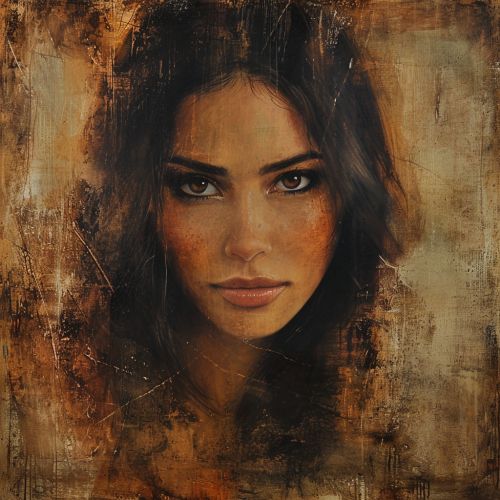Femme fatale
Origins and History
The term "femme fatale", originating from French, translates to "fatal woman" or "disastrous woman". It is used to describe a character archetype that has been a part of storytelling and art for centuries. The femme fatale is a woman who uses her seductive qualities and cunning to manipulate men, often leading them to their downfall.
The concept of the femme fatale can be traced back to ancient mythology. In Greek myths, characters such as Medusa and Circe embody the femme fatale archetype. These women used their beauty and allure to deceive men, often leading to tragic outcomes.


In the Middle Ages, the femme fatale was often depicted as a witch or sorceress, using her powers to ensnare men. This portrayal continued into the Renaissance, with characters like Lady Macbeth in Shakespeare's works.
The term "femme fatale" itself came into popular use during the 19th century, particularly in French literature. It was used to describe a woman who was irresistibly attractive, but ultimately destructive.
Characteristics
The femme fatale is characterized by her seductive and manipulative nature. She is often portrayed as being exceptionally beautiful, using her physical attractiveness to lure men into her web. However, her beauty is not her only weapon. The femme fatale is also highly intelligent and cunning, using her wits to manipulate situations to her advantage.
The femme fatale is often depicted as being independent and self-reliant. She does not conform to societal expectations of women, and instead, uses her femininity as a tool to gain power and control. This makes her a complex and multi-dimensional character, often seen as a symbol of female empowerment.
However, the femme fatale is also often portrayed as being morally ambiguous. Her actions often lead to harm or destruction, and she is typically seen as a villain or antagonist. This moral ambiguity adds to her allure and mystique, making her a fascinating and compelling character.
In Literature
The femme fatale has been a popular character archetype in literature for centuries. She is often portrayed as a seductive and manipulative woman who uses her allure to ensnare men, leading to their downfall.
In the 19th century, the femme fatale became a popular character in French literature. Characters like Madame Bovary in Gustave Flaubert's novel of the same name and Carmen in Prosper Mérimée's novella are classic examples of the femme fatale archetype.
In the 20th century, the femme fatale became a staple of film noir and hard-boiled detective novels. Characters like Brigid O'Shaughnessy in Dashiell Hammett's "The Maltese Falcon" and Cora Papadakis in James M. Cain's "The Postman Always Rings Twice" are iconic femme fatales of this era.
In Film
The femme fatale has been a popular character in film, particularly in the film noir genre. Film noir, a style of filmmaking characterized by cynical characters, stark lighting, and complex plots, often features the femme fatale as a central character.
In these films, the femme fatale is often portrayed as a dangerous and seductive woman who uses her allure to manipulate men. She is often involved in a plot of deception or crime, and her actions often lead to the downfall of the male protagonist.
Some of the most iconic femme fatales in film include Phyllis Dietrichson in "Double Indemnity", Kathie Moffat in "Out of the Past", and Veda Pierce in "Mildred Pierce".
In modern cinema, the femme fatale continues to be a popular character archetype. Films like "Basic Instinct", "Fatal Attraction", and "Gone Girl" feature modern interpretations of the femme fatale.
Impact and Influence
The femme fatale has had a significant impact on popular culture and has influenced the portrayal of female characters in literature, film, and other media.
The femme fatale is often seen as a symbol of female empowerment. She is a woman who uses her intelligence and sexuality to navigate a world dominated by men. This makes her a complex and multi-dimensional character, and her portrayal often challenges traditional gender roles and expectations.
However, the femme fatale is also often portrayed as a villain or antagonist. Her actions often lead to harm or destruction, and she is typically seen as a morally ambiguous character. This portrayal has led to criticism, with some arguing that it perpetuates negative stereotypes about women.
Despite this, the femme fatale remains a popular and enduring character archetype. Her allure and mystique continue to captivate audiences, and her influence can be seen in a wide range of media.
